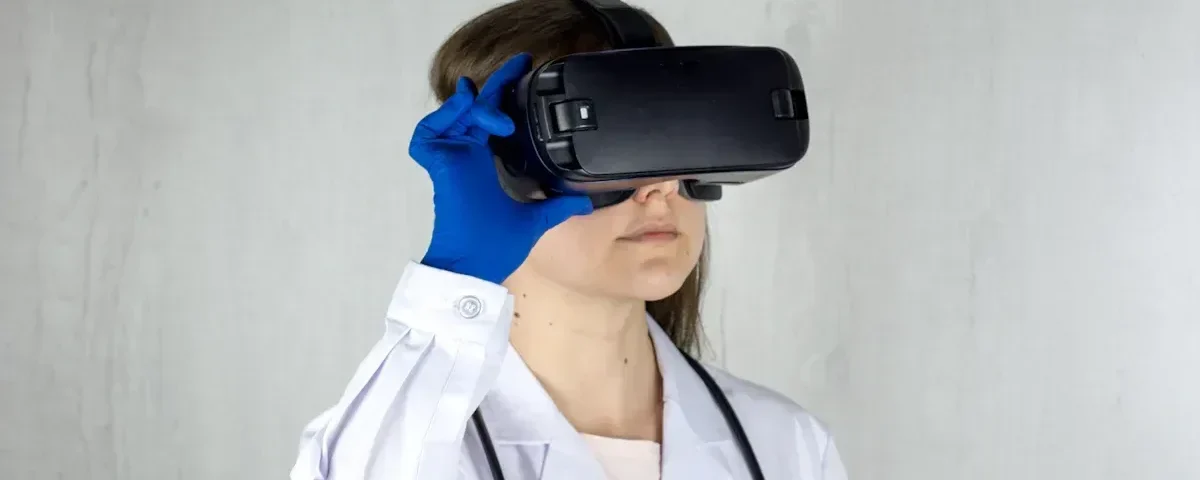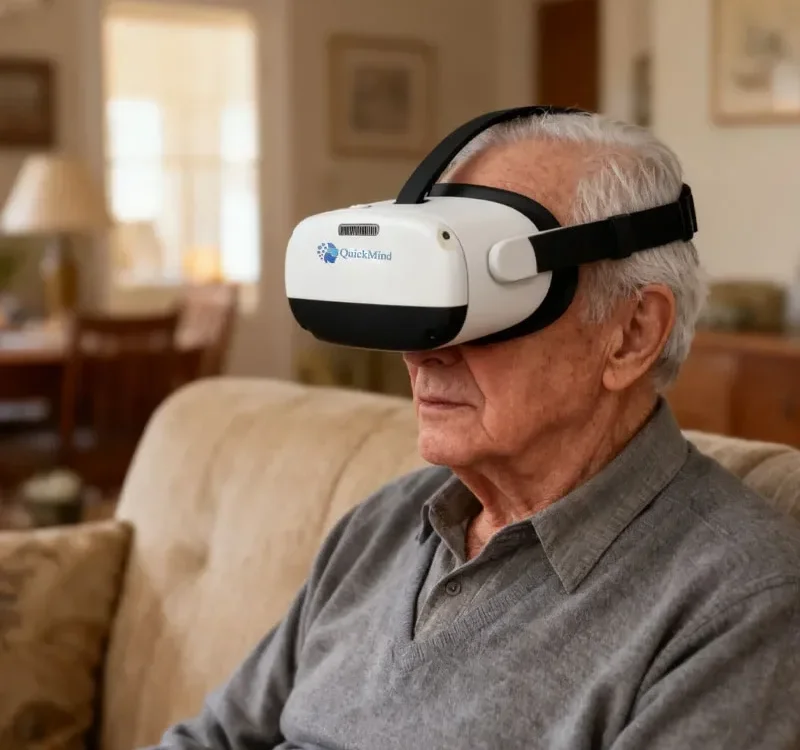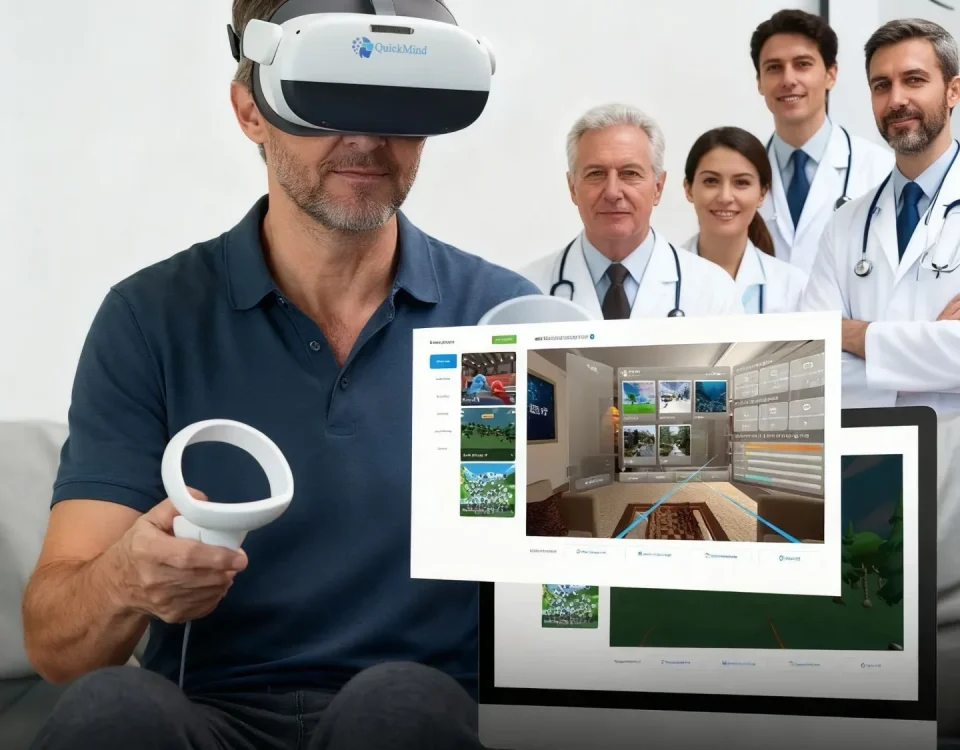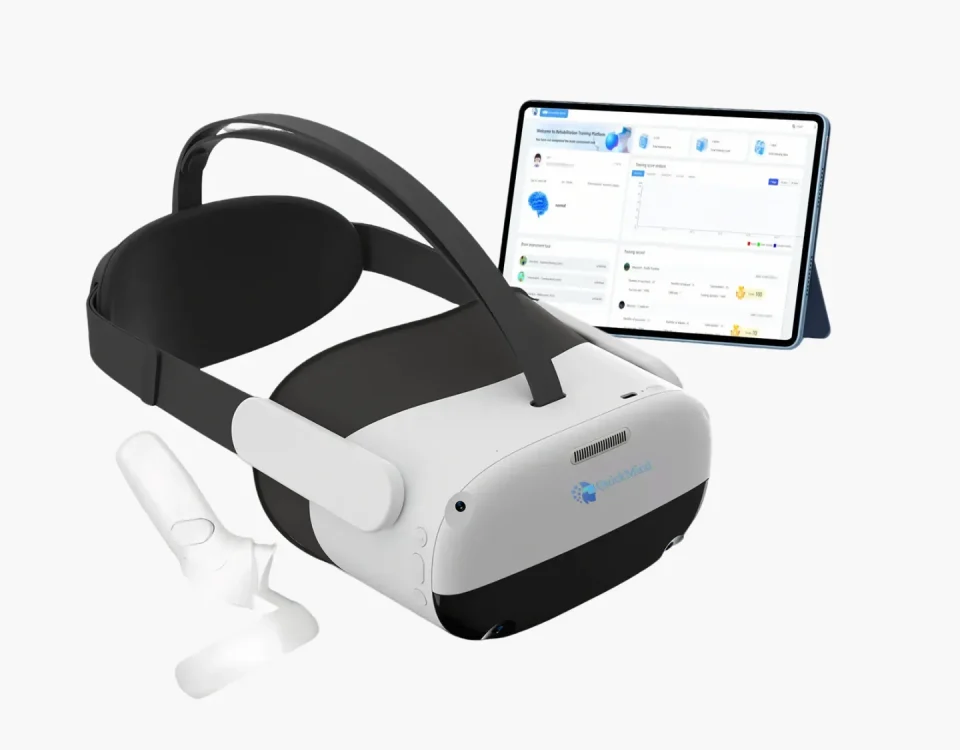
What Is Cognitive Rehabilitation and How Does It Work
2025-10-20
VR Cognitive Rehabilitation Rental provides access to advanced virtual reality systems for cognitive therapy without the commitment of ownership. Modern solutions, such as QuickMind®, combine FDA clearance, AI-powered personalization, and real-time progress tracking to deliver measurable results. Clinics, caregivers, and individuals seeking home or remote therapy all benefit from this service. The market for virtual rehabilitation, valued at USD 582.60 million in 2024, is projected to reach USD 2,032.18 million by 2031, with a 19.5% annual growth rate.
- Patients gain access to cutting-edge technology.
- Caregivers and clinics streamline therapy delivery.
- Home users enjoy flexibility and convenience.
| System Name | FDA-Cleared | AI-Powered | Clinical Outcomes |
|---|---|---|---|
| QuickMind | Yes | Yes | 95% consistency in cognitive screenings, personalized training plans, and quantifiable progress tracking. |
| Neuro Rehab VR | Yes | Yes | Improves balance, range of motion, pain management, gait training, cognition, vestibular rehabilitation, and hand-eye coordination. |
Consider how an innovative rental service could support cognitive health needs for you or someone important in your life.
Key Takeaways
- VR Cognitive Rehabilitation Rental offers advanced therapy technology without the need to buy equipment.
- Users can customize therapy plans to fit their specific needs, enhancing engagement and effectiveness.
- Flexible rental options make therapy more affordable and accessible for individuals and clinics.
- Ongoing support and training ensure users feel confident and empowered during their rehabilitation journey.
- This service benefits a wide range of individuals, including those recovering from strokes or brain injuries.
How VR Cognitive Rehabilitation Rental Works

Rental Process Overview
VR Cognitive Rehabilitation Rental offers a streamlined process that makes advanced therapy accessible to clinics, caregivers, and individuals. The journey begins with selecting a reputable provider. Many users start by researching online or consulting healthcare professionals for recommendations. After choosing a provider, users typically follow these steps:
- Consultation and Needs Assessment
Providers assess the user’s cognitive rehabilitation needs, therapy goals, and environment—whether at home or in a clinic. - System Selection and Customization
The provider recommends a suitable system, such as QuickMind, and customizes the therapy plan based on the user’s profile. - Delivery and Setup
The equipment arrives pre-configured. Providers often offer remote or in-person setup assistance to ensure a smooth start. - Training and Onboarding
Users and caregivers receive training on operating the VR system, navigating therapy modules, and tracking progress. - Ongoing Support and Monitoring
Providers offer technical support, monitor user progress, and adjust therapy plans as needed.
Tip: Many providers offer flexible rental periods, allowing users to extend or modify their plans as therapy progresses.
Equipment and Technology
Modern VR Cognitive Rehabilitation Rental systems feature advanced hardware and intelligent software. QuickMind stands out with its FDA-cleared platform, combining immersive VR, AI-driven personalization, and eye-tracking technology. The equipment typically includes:
- Lightweight VR headsets for comfort and ease of use.
- Hand controllers for interactive exercises.
- Sensors for motion and eye-tracking.
- Pre-installed software with therapy modules.
The following table highlights how AI and eye-tracking technologies enhance the rehabilitation experience:
| Feature | Description |
|---|---|
| Personalized Experience | QuickMind adapts to individual needs using AI and VR technology. |
| Real-time Adjustments | The system modifies rehabilitation plans based on current abilities. |
| Eye-tracking Technology | Assesses cognitive functions and customizes exercises for specific deficits. |
| Immersive Scenarios | Engages users in realistic environments that challenge cognitive skills. |
| Performance Analysis | AI analyzes user performance and adjusts task difficulty in real time. |
| Feedback Mechanism | Eye-tracking provides data for therapists to tailor rehabilitation plans. |
This technology ensures that each session remains engaging, effective, and tailored to the user’s progress.
User Experience
Users of VR Cognitive Rehabilitation Rental systems report high satisfaction with both comfort and usability. The immersive nature of VR therapy allows individuals to control stimuli, which can reduce embarrassment and anxiety during sessions. Customizable therapy games and exercises help maintain interest and motivation, leading to better compliance and outcomes.
Therapy sessions vary in duration and frequency, depending on the user’s needs and the provider’s recommendations. The table below summarizes findings from recent studies:
| Study | Average Session Duration | Frequency of Sessions | Total Intervention Duration |
|---|---|---|---|
| The Effects of Virtual Reality–Based Reminiscence Therapies for Older Adults With Cognitive Impairment | 13.33 min | 49.50 sessions | 2.50 wks |
| The Effects of Virtual Reality–Based Reminiscence Therapies for Older Adults With Cognitive Impairment | 40 min | N/A | 8 to 12 weeks |
| Appropriate Number of Treatment Sessions in Virtual Reality-Based Individual Cognitive Behavioral Therapy for Social Anxiety Disorder | N/A | 1 session/week | 9 to 10 weeks |
- Users appreciate the ability to control the pace and intensity of therapy.
- Customization options keep therapy engaging and relevant.
- High satisfaction rates often lead to better adherence and improved rehabilitation outcomes.
VR Cognitive Rehabilitation Rental empowers users to participate in therapy on their own terms, whether at home or in a clinical setting. The combination of advanced technology, personalized care, and ongoing support creates a positive and effective rehabilitation experience.
Who Benefits from VR Cognitive Rehabilitation Rental

Target Users
VR Cognitive Rehabilitation Rental serves a diverse group of individuals and organizations. Patients with cognitive impairments often seek these services to improve daily functioning. Clinics and rehabilitation centers use VR systems to enhance therapy outcomes and streamline care delivery. Caregivers benefit from increased engagement and adaptability, which supports their efforts in managing patient progress. The following groups frequently utilize these rental solutions:
- Patients recovering from stroke
- Individuals with traumatic brain injury
- Those experiencing mild cognitive impairment
- People diagnosed with neurodegenerative diseases, including Alzheimer’s disease
Clinics and caregivers report higher engagement and adaptability when using VR-based interventions. Studies show that VR enhances caregiving competence and provides immediate feedback, which increases patient compliance and satisfaction. Programs such as Dementia Live™, Into D’mentia, and Virtual Dementia Tour (VDT®) demonstrate the practical benefits of VR in clinical and home settings.
| Evidence Type | Findings | Source |
|---|---|---|
| Meta-analysis | VR-based interventions improve caregiving competence. | Link |
| Study Count | Nine studies included, varying in quality. | Link |
| Key Programs | Dementia Live™, Into D’mentia, Virtual Dementia Tour (VDT®) | Link |
Note: VR Cognitive Rehabilitation Rental offers high ecological validity through sensorimotor interaction, which supports real-world skill development.
Conditions Addressed
Rental programs address a wide range of cognitive and neurological conditions. The technology supports tailored rehabilitation plans that target specific deficits and promote neural plasticity. Commonly addressed conditions include:
| Condition | Description |
|---|---|
| Traumatic Brain Injuries (TBI) | Affects cognitive functioning due to physical damage to the brain. |
| Neurological Impairments | Includes various disorders affecting the nervous system, impacting cognitive abilities. |
| Cognitive Deficits | General term for reduced cognitive function, which can arise from various medical conditions. |
Patients with stroke, TBI, or dementia often experience improved activities of daily living after regular engagement with VR content. VR-based therapy provides unconstrained interfaces and high-intensity, multisensory tasks, which are essential for enhancing neural plasticity. The ability to mimic real-life scenarios and deliver immediate feedback makes VR Cognitive Rehabilitation Rental a valuable resource for both patients and professionals.
Benefits of VR Cognitive Rehabilitation Rental
Cost and Flexibility
VR Cognitive Rehabilitation Rental offers a cost-effective alternative to purchasing equipment or attending frequent in-person therapy sessions. Users avoid large upfront investments in hardware and software. Instead, they pay manageable recurring fees that reflect only the duration and intensity of their therapy needs. The total cost of VR therapy includes the system’s useful life, initial setup, and ongoing monthly expenses. Over time, this approach can lead to significant savings compared to traditional therapy models.
Many users discover that renting VR cognitive rehabilitation equipment reduces financial barriers and allows for more frequent or extended therapy sessions.
Flexible payment and rental options further enhance accessibility. Health insurance companies often cover the costs of VR cognitive rehabilitation services. Rental devices for VR headsets are available, ensuring that users can access advanced therapy without personal financial strain. This flexibility empowers clinics, caregivers, and individuals to tailor therapy plans to changing needs.
- Health insurance coverage for VR cognitive rehabilitation
- Rental devices available for short- or long-term use
- No need for large upfront investments
Access to Advanced Therapy
VR Cognitive Rehabilitation Rental provides access to advanced therapy features that standard approaches cannot match. Users benefit from immersive engagement and enhanced neuroplastic conditions. Quantitative assessment capabilities allow for precise tracking of progress. Personalized progression algorithms adapt therapy to each individual’s needs.
- Enhanced neuroplastic conditions
- Immersive engagement in therapy tasks
- Quantitative assessment and progress tracking
- Personalized progression algorithms for optimal outcomes
- Pain management and anxiety reduction
- Comprehensive rehabilitation protocols
These features support a higher level of care. Advanced VR cognitive rehabilitation systems increase engagement, motivation, and adherence to therapy. Multisensory stimulation promotes neuroplastic changes, leading to improved cognitive and motor outcomes. Participants using VR-based dual-task training often achieve better results than those using traditional methods.
A recent study by De Luca et al. indicated improvement in global cognitive and executive functions for all patients, with those undergoing VR treatment showing better outcomes.
Convenience and Support
VR Cognitive Rehabilitation Rental delivers unmatched convenience for both home and clinical users. The rental model allows therapy to fit into daily routines, reducing the need for travel or rigid scheduling. Users can access therapy modules at any time, making it easier to maintain consistency and momentum in their rehabilitation journey.
Providers offer comprehensive support throughout the rental period. Technical assistance ensures smooth setup and operation. Ongoing monitoring and remote adjustments keep therapy plans aligned with user progress. This level of support helps users and caregivers feel confident and empowered.
- Therapy available at home or in clinics
- Flexible scheduling to fit individual routines
- Remote monitoring and plan adjustments
- Technical support for setup and troubleshooting
VR Cognitive Rehabilitation Rental combines advanced technology, flexible access, and professional support to create a seamless and effective rehabilitation experience.
How to Rent VR Cognitive Rehabilitation
Finding Providers
Individuals and clinics seeking VR Cognitive Rehabilitation Rental should begin by identifying reputable providers. A careful evaluation ensures the best fit for therapy needs. The following table outlines key criteria for selecting a provider:
| Criteria | Description |
|---|---|
| Availability of Information | Providers must offer clear details about their services. |
| Consumer Satisfaction | User feedback helps gauge service quality and satisfaction. |
| Qualifications of Providers | Credentials and expertise indicate the provider’s reliability. |
| Types of Services Offered | A range of services supports diverse rehabilitation needs. |
| Cost, Accessibility, and Duration | Transparent pricing, easy access, and flexible rental periods are essential. |
| Integrated Settings | Services should support integration with community or clinical environments. |
| Outcomes Achieved | Providers should share data on therapy success rates. |
Tip: Reading reviews and consulting healthcare professionals can help narrow down the best options.
Rental Steps
Renting a VR cognitive rehabilitation system involves several straightforward steps:
- Research and shortlist providers based on the criteria above.
- Contact providers to discuss therapy goals and specific needs.
- Review available systems and select the most suitable option.
- Confirm rental terms, including duration, cost, and included services.
- Complete the rental agreement and arrange for equipment delivery.
Providers often offer both home and clinic-based solutions. They may also customize therapy plans to match individual requirements.
Setup and Support
Proper setup ensures a smooth therapy experience. Most systems require a dedicated space of at least 20 m². Essential equipment, such as VR headsets and motion sensors, must be included. In clinical settings, supervision by trained professionals is recommended. At home, users can follow guided instructions for independent sessions.
Providers support renters with resources such as help centers, manuals, and international assistance. For example, users can access troubleshooting guides and contact support teams for technical issues. Weekly program modifications by professionals help maintain therapy effectiveness.
Note: Reliable support and clear setup instructions contribute to a positive rehabilitation journey.
What to Consider Before Renting
Technical Needs
Selecting a VR cognitive rehabilitation rental system requires careful attention to technical requirements. Each user brings unique needs, especially those with cognitive or sensory impairments. Providers design systems with user-centered principles, ensuring technology adapts to individual abilities. The following table highlights key design considerations:
| Design Consideration | Implication for User Needs |
|---|---|
| User-centered design | Technology aligns with individual requirements, supporting those with cognitive challenges. |
| Sensory performance | VR experiences adjust to match users’ sensory capabilities. |
| HCI guidelines | Systems adapt to sensory and perceptual deficits, improving comfort and usability. |
Technical difficulties can discourage users and reduce engagement. Accessibility remains a top priority, as frustration with inconsistent operation may lead to abandonment. Providers recommend evaluating the physical and communication abilities of users before selecting a system.
Support and Safety
Support and safety protocols play a vital role in the rental experience. Providers establish clear procedures for handling equipment malfunctions, power interruptions, or user distress. They recommend setting up VR sessions in spacious, well-lit, and obstacle-free areas. Physical boundaries and floor indicators help users remain aware of their surroundings.
- Providers encourage access to mental health professionals for emotional support.
- Debriefing sessions address any challenges that arise during therapy.
- VR offers a controlled environment, allowing safe practice of skills that may be risky in real life, such as cooking or driving.
Monitoring for VR sickness, such as dizziness or discomfort, ensures user safety and comfort throughout each session.
Customization Options
Customization options allow therapists and users to tailor therapy to specific goals. Advanced systems offer flexibility in environment type, sensory input, and task difficulty. The table below outlines common customization features:
| Customization Aspect | Description |
|---|---|
| Environment Type | Choose from indoor, outdoor, high or low stimulation settings. |
| Sensory Input | Adjust noise, lighting, and motion visuals for comfort. |
| Task Difficulty | Range from passive observation to complex dual-task activities. |
| Functional Objectives | Focus on skills like balance, navigation, or planning. |
| Time & Progression | Control session pace and progression for optimal outcomes. |
Therapists can modify scenarios or create new ones, ensuring therapy remains relevant and engaging. This adaptability promotes neuroplasticity, enhances motivation, and supports lasting recovery. A balance between autonomy and structure helps users achieve better adherence and improved results.
VR cognitive rehabilitation rental delivers advanced therapy with flexibility and measurable results. Users gain access to innovative technology, personalized care, and ongoing support. This service removes barriers for clinics, caregivers, and individuals seeking effective cognitive therapy.
- Explore reputable providers for tailored solutions.
- Consult healthcare professionals for guidance.
- Consider a trial rental to experience the benefits firsthand.
VR cognitive rehabilitation rental empowers users to take control of their cognitive health journey.
FAQ
What is included in a typical VR cognitive rehabilitation rental package?
A standard rental package provides a VR headset, hand controllers, pre-installed therapy software, and setup instructions. Providers may offer remote support and training for users and caregivers.
How long does setup take for home users?
Most users complete setup in less than 30 minutes. Providers supply step-by-step guides and remote assistance to ensure a smooth experience.
Can therapy plans be customized for individual needs?
Therapists adjust therapy modules based on user progress and goals. QuickMind® uses AI to personalize exercises and track performance.
Is technical support available during the rental period?
Providers offer ongoing technical support. Users can access help centers, troubleshooting guides, and direct assistance for equipment or software issues.
Which conditions benefit most from VR cognitive rehabilitation?
| Condition | Benefit |
|---|---|
| Stroke | Improved cognition |
| TBI | Enhanced daily skills |
| Dementia | Increased engagement |
Tip: Consult a healthcare professional to determine the best therapy plan for specific needs.





